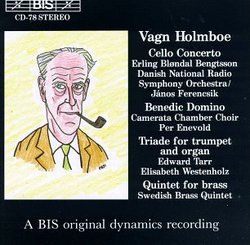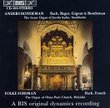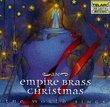| All Artists: Vagn Holmboe, Janos Ferencsik, Per Enevold, Danmarks Radiosymfoniorkester, Elisabeth Westenholz Title: Vagn Holmboe: Cello Concerto; Benedic Domino; Triade; Quintet for Brass Members Wishing: 1 Total Copies: 0 Label: Bis Release Date: 9/22/1994 Album Type: Import Genre: Classical Styles: Opera & Classical Vocal, Chamber Music, Forms & Genres, Concertos, Instruments, Strings Number of Discs: 1 SwapaCD Credits: 1 UPC: 750582508523 |
Search - Vagn Holmboe, Janos Ferencsik, Per Enevold :: Vagn Holmboe: Cello Concerto; Benedic Domino; Triade; Quintet for Brass
 | Vagn Holmboe, Janos Ferencsik, Per Enevold Vagn Holmboe: Cello Concerto; Benedic Domino; Triade; Quintet for Brass Genre: Classical
|
Larger Image |
CD DetailsSimilar CDs
|
CD ReviewsA highly varied programme of fine pieces Christopher Culver | 11/10/2009 (4 out of 5 stars) "This venerable BIS disc presents four pieces by Vagn Holmboe recorded in the 1970s and 1980s with a variety of Nordic performers. Though this disc is much less visible in the label's catalogue than its recent Holmboe symphonic and concerto cycles, it is still essential listening for fans of the composer.
Holmboe's personal style was neoclassicism, but with a focus on organic growth that recalls the Nordic tradition. While Holmboe remained committed to the tonal idiom throughout his career, his works are carefully balanced to avoid emotional excess and bombast. "Elegant" and "refined" are two adjectives I think best describe his music, though that's not to say he can't surprise you. The Cello Concerto op. 120 (1974) is sure to appeal to anyone who loves the symphonies of this era, especially the Ninth. Cast in one movement, it nonetheless falls into three major sections. The first is what one typically expects from a concerto, a dialogue between the solo instrument and various parts of the orchestra, some blending with the cello and others antagonistic. In the second section, the cello suddenly falls away as the spotlight falls exclusively on the orchestra, and here is where the climax of the piece is found with a lovely five-note theme on the horn. The way in which the main musical line disappears to be replaced by what appears the secret heart of the work will remind listeners of the third movement of Sibelius' Fifth. The final section is a solo cadenza for cello. In this recording Janos Ferencsik leads the Danish National Radio Symphony Orchestra, with Erling Blondal Bengtsson as soloist. "Triade" for trumpet and organ op. 123 (1974) opposes the nature of its instruments placed into an unusual combination. The trumpet plays a slow, almost song-like line, while the organ is able to produce complex polyphony. The three movements of the piece are based on the same general material. Edward Tarr plays trumpet, while the organist is Elizabeth Westenholz. The Quintet for brass No. 1 op. 79 is a four-movement work. Here the initial movement announces a theme in a cold, austere style and the following movements develop this material in directions ranging from comic to sad. The performance here comes from the Swedish Brass Quintet. "Benedic Domino" for choir a cappella op. 59a (1958) is a remarkable work where Holmboe uses only a handful of voices and keeps them clearly delineated, avoiding the muddle of so many choral pieces. The venerable Danish choir Camerata performs, conducted by Per Enevold. While the best introduction to Holmboe is the symphonies (especially the Eighth), don't stop there, for all of his music is of very high quality." |

 Track Listings (10) - Disc #1
Track Listings (10) - Disc #1


